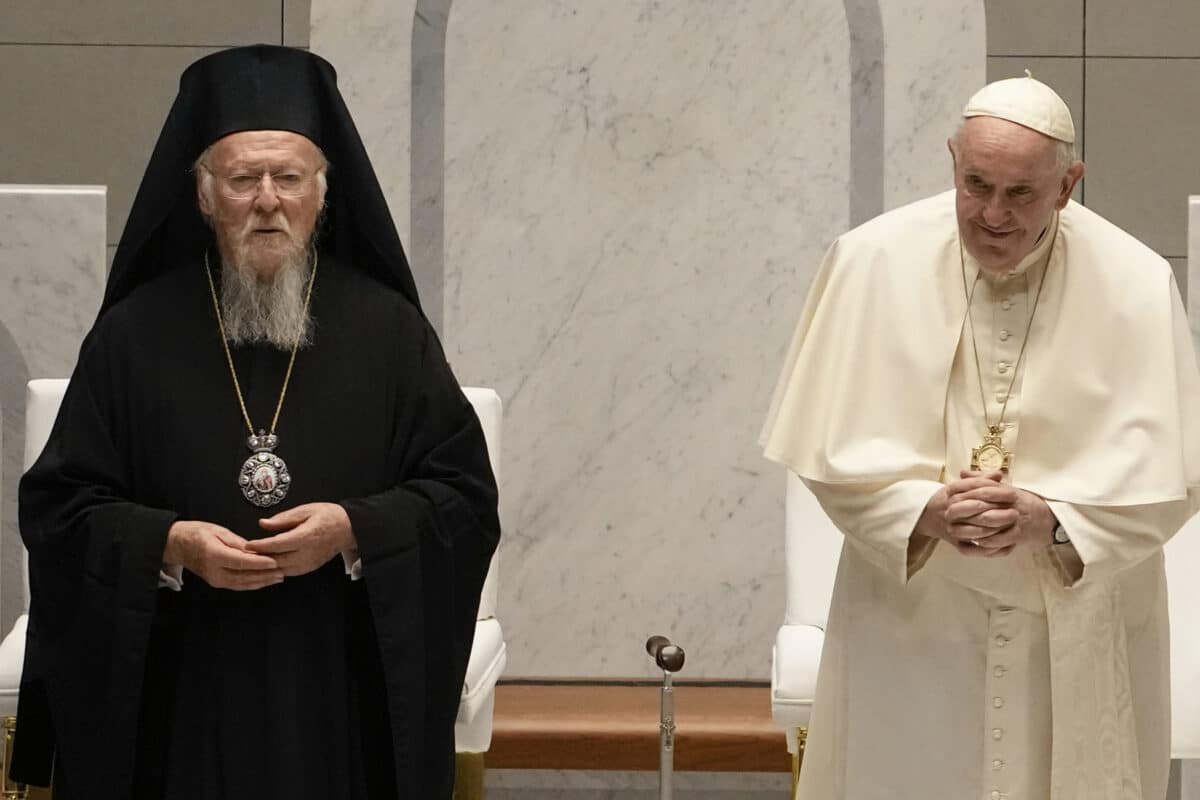
Pope Francis and Ecumenical Patriarch Bartholomew attend an ecumenical assembly and prayer for peace in Our Woman of Arabia Cathedral, Sakhir, Bahrain, Friday, Nov. 4, 2022. | AP File picture
ATHENS, Greece – For greater than 400 years, Catholic and Orthodox church buildings have used other ways to find out the date of Easter Sunday.
However this Sunday will mark a particular second for Christians, because the church buildings have a good time of Jesus’ resurrection on the identical day.
What’s extra, prime spiritual leaders — together with Pope Francis — are expressing a want to maintain it that method. However the uncommon alignment has stirred underlying distrust between the 2 main Christian communions.
Calendars and calculations differ
The movable date for Easter follows a seemingly simple rule: the Sunday following the primary full moon on or after the spring equinox.
However the two church buildings began utilizing completely different calendars after Pope Gregory XIII’s adaptation in 1582, when the Western church adopted the Gregorian calendar whereas the Jap Orthodox Church stored the older Julian one.
Furthermore, every church makes use of its personal ecclesiastical calculations for lunar cycles and the equinox, which don’t neatly match scientific projections.
The result’s that Easter dates might be as a lot as 5 weeks aside. They will coincide in back-to-back years, or a decade can go with out it occurring.
Pope Francis’ want
Days earlier than his five-week hospitalization, Pope Francis referred to this yr’s Easter celebration whereas invoking the 1,700th anniversary of the historic Council of Nicaea, when Christian leaders gathered to settle foundational disputes concerning the religion.
“As soon as once more, I renew my attraction: Let this coincidence function an indication — a name to all Christians to take a decisive step towards unity round a standard date for Easter,” Francis stated whereas main prayers on the Basilica of St. Paul in Rome.
Francis’ invitation, delivered on the finish of a prayer for Christian Unity with Orthodox monks current, wasn’t new. Getting back from a visit to Turkey in 2014, he advised reporters on the airplane {that a} unified date could be logical.
“It’s a bit ridiculous,” he stated, then staged a fake dialog: “‘Inform me, your Christ, when is he resurrected? Subsequent week? Mine was resurrected final week.’”
He has discovered an ally in Ecumenical Patriarch Bartholomew, a fellow octogenarian and religious chief of the world’s Orthodox Christians. The 2 “converse to 1 one other like brothers,” Francis has stated. For his half, Bartholomew has known as Francis “our elder brother” and described the Easter initiative as “an actual step towards repairing outdated conflicts.”
Solely winners, no losers?
The concept of a standard Easter has been mentioned because the Sixties, with curiosity typically peaking when celebrations coincide. The important thing impediment has at all times been the implication that one facet would wish to concede.
Protestants, who observe the identical calendar as Catholics, have additionally been in on the discussions.
The Geneva-based World Council of Church buildings — a fellowship of Orthodox and Protestant our bodies — has proposed a compromise. It suggests utilizing trendy astronomy, basing the calculation on Jerusalem time and following the identical fundamental rule set centuries in the past.
“It has by no means been extra essential than now, as a result of we reside in a polarized world and folks everywhere in the world yearn for extra unity,” Lutheran Bishop Heinrich Bedford-Strohm, a senior WCC official, advised The Related Press from his house exterior Berlin. “All different questions – on calendar, on time, on the moon and the celebs and every thing – it’s not major; it’s secondary.”
‘Strings hooked up’
Whereas the pope’s needs might carry highly effective affect via the Vatican’s extremely centralized authority, Bartholomew’s position is basically symbolic over the self-governed nationwide and native church buildings. And discussions between Russia, the Orthodox world’s most populous nation, and church buildings of different Orthodox-majority nations stay stalled as a result of struggle and church divisions in Ukraine.
Additional complicating prospects for consensus is a historical past characterised by centuries of distrust, largely pushed by wariness within the East concerning the Vatican’s supremacy.
At a Holy Week service Monday in Athens, Father Anastasios welcomed parishioners into the Church of Saint Dimitrios Loumbardiaris, a restored stone chapel close to the Acropolis. He stated he helps forging bonds with Christianity’s different branches — however with warning.
“We are able to attempt to construct bridges, however we can’t distort our religion or the traditions of our ancestors, or the dogmas Christ himself handed down,” he stated. “There are deeply rooted variations. From my view and that of many individuals right here, the unity sought prior to now by the Roman Catholic Church typically wasn’t honest; it got here with strings hooked up, was extra about dominance than real reconciliation.”
‘Nice concord’
As dialogue between the church buildings slowly unfolds, frequent Easter celebrations are already a sensible actuality in a number of locations. The Orthodox Church in Finland switched dates within the Twenties to align celebrations with the Lutheran majority. And Catholics in Greece — whereas making no official change to their calendar — have celebrated with the remainder of the nation since 1970.
Joseph Roussos, a member of a Catholic neighborhood on the Greek island of Syros, took his first journey to the Vatican final month.
At age 67, he remembers when Easters in Greece have been separate: when colleges and shopkeepers on the island closed for various holidays, and the church bells tolled mournfully throughout two distinct Holy Weeks.
“It wasn’t state of affairs. However once we did have a good time Easter collectively, there was nice concord,” he stated. “We reside very nicely (immediately), and it’s really lovely. I hope it stays that method.”
Learn Subsequent

